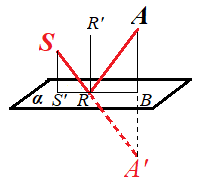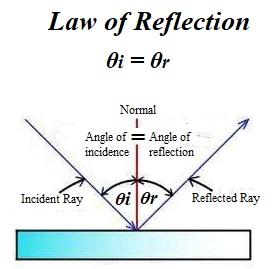Reflection
Reflection and refraction are effects of changing the direction of light propagation after the light hits some surface or, more precisely, when light reaches the border between two different media, "old", where it's coming from, and "new", which the light hits on its path.
Reflection happens when light returns back to the "old" medium after hitting its border with a "new" medium and continues to propagate there in a different direction, while refraction is the penetration of the light inside the "new" medium, where it continues to propagate in, generally speaking, different direction and different speed, as compared to the original direction and speed.
In this lecture we will address the effect of reflection.
Before addressing the Laws of Reflection, let's accept as an intuitively understood axiom, the Fermat's Principle of the Least Time of light propagation. This principle, proposed by French mathematician Pierre Fermat in 1662, states that the light travels from its source to some point along such a trajectory that the travel time is the least among all possible trajectories.
In particular, if the environment the light travels through is uniform (like vacuum or glass of a uniform consistency), the light travels along a straight line, because a straight line is the shortest distance between any two points, which results in the least travel time for light that travels with a constant speed.
It means that, if the source of light S emits light in all directions in a uniform environment, at some observing point A we see only the ray that travels along a straight line SA.
Reflection is easily understood from the viewpoint of the corpuscular theory of light, which might be a factor in dominance of this theory, when scientists first attempted to understand the nature of light.
Indeed, reflected light behaves exactly like billiard balls hitting the border of a billiard table.
Many experiments have shown that the direction of the reflected ray of light is determined by its initial direction before it hits the reflecting border between two media and the geometry of this border.
Consider the simplest case of a border between two media being an ideal plane that reflects all the light coming on it, like a mirror.
Let's examine how the light is reflected by this mirror from the viewpoint of the Fermat's Principle of the Least Time.
Let point S be a source of light. Choose one particular ray emitted by it at a certain angle to a plane of a mirror (this is an angle between a line of a ray and a plane of a mirror, which is measured as an angle between this line and its projection on the plane).
This ray is reflected by a mirror. Let point A be any point on the reflected ray.
Before hitting a mirror the ray travels within a uniform environment along a straight line. After the reflection light also travels to point A in a uniform environment along another straight line.
Our task is to determine a point R, where the light hits a reflecting plane before traveling to point A.
Since both segments the light travels (SR before hitting a mirror and RA from a reflecting mirror to point A) are in the same environment, where the speed of light is the same, the Principle of the Least Time will be satisfied if the whole distance from the source S to a reflection point R and to point A is minimal among all possible trajectories.
Consider now a purely geometric problem. Given two points in space S and A on the same side of a plane α, find a point R on plane α such that the sum of the lengths of two segments SR and RA is minimal.
The following picture represents a solution:

Find a point A' symmetrical to point A relatively to a given reflecting plane α by dropping a perpendicular to plane α from point A and choose on this perpendicular point A' on the opposite side of a plane such that AB=BA', where B is intersection point of this perpendicular with plane α.
Next, connect points S and A' by a straight line. Point R is an intersection of line SA' with plane α. From equality of right triangles ΔARB and ΔA'RB, that follows from the equality of their catheti, follows equality of hypotenuses RA and RA'.
The point R is the point where reflection occurs and the sum of distances SR and RA is the least among all other reflection points on plane α.
Indeed, consider any other point R' as the reflection point. It's obvious that R'A=R'A' (analogously to why RA=RA', as proved above) and, therefore,
SR'+R'A=SR'+R'A'
is greater than
SR+RA=SR+RA'=SA'
because SR+RA' is a straight line, while SR'+R'A' is not.
So, any other ray, not coinciding with AR, will not hit point A because the trajectory from point S to a different reflection point R' and then to point A will be longer than straight line SA'.
The following easily provable statements are direct consequences of the method of construction of the reflection point R.
(a) Plane of light rays β that contains initial ray of light SR and reflected ray of light RA is perpendicular to a reflecting plane α because it contains the point A' that lies on a continuation of line SR and it goes through a perpendicular to α line AA'.
(b) Projection S' of the source of light S onto reflection plane α also lies in the plane β because line SS' is parallel to AA' that belongs to plane β and point S is on that plane as well.
(c) Perpendicular RR' from a reflection point R to reflecting plane α (normal to plane α at the point of reflection) also lies in the plane β because line RR' is parallel to AA' that belongs to plane β and point R is on that plane as well.
(d) Points S', R and B lie on the same straight line - the line of intersection of two planes α and β; from this follows that ∠SRS' equals to ∠A'RB as vertical within plane β.
(e) ∠A'RB equals to ∠ARB from the equality of triangles ΔARB and ΔA'RB within plane β.
(f) ∠SRS' equals to ARB, as follows from the two previous statements.
(g) Complementary to the two equal angles of the previous statement, incidence angle ∠SRR' (between an incident ray and a normal to a reflecting plane at the reflection point) and reflection angle ∠ARR' (between a reflected ray and a normal to a reflecting plane at the reflection point) also are equal to each other.
The last statement about equality of an incidence angle and a reflection angle is very important.
Now, using the properties described above, we can formulate the Laws of Reflection as consequences of the Fermat's Principle of the Least Time.
1. Three lines, an incident ray, a normal to a reflection plane at a point of reflection and a reflected ray, lie in the same plane.
2. An incidence angle equals to a reflection angle.
3. Incident and reflected rays lie on different sides relatively to a normal at a point of reflection.

Let's support our derivation of the above Laws of Reflection, based on the Principle of the Least Time, with more physical considerations from the viewpoint of the corpuscular theory that states that the ray of light is a set of particles flying in the same direction with certain constant speed along a straight line.
Consider a frame of reference with XY-plane being the reflecting plane and a light particle flying with constant linear speed from some point in the second quadrant of the XZ-plane towards the origin of coordinates along a straight line, so its Y-coordinate and Y-component of its speed are always zero.
Then the above picture represents the trajectory in the XZ-plane.
Assume that a ray of light originated at time t=0 at a distance D from the incidence point (from the origin of coordinates) and flies toward it along a straight line at an angle of incidence θi with constant speed c.
The ray will reach a point of incidence at the time moment T=D/c, at which point its coordinates will be {x(T)=0;y(T)=0;z(T)=0}.
At the incidence point the velocity vector of a light particle will be
Vi(t)={c·sin(θi);0;−c·cos(θi)}.
Assuming the ideally elastic reflection, the X-component of the particle's velocity will be unchanged because it's parallel to the reflective XY-plane, Y-component will remain at zero, while Z-component after the contact with reflecting XY-plane will be inversed by an ideal reflection.
Therefore, the velocity vector of a light particle after the reflection will be
Vr(t)={c·sin(θi);0;c·cos(θi)}.
After the reflection the light will go along the trajectory that coincides with its velocity vector.
Since Y-component of the velocity vector was, is and will always be zero, the reflected ray from the reflection point (the origin of coordinates) will continue its motion within the same XZ-plane it came from. So, the incident ray, normal to a reflecting XY-plane (that is, Z-axis) and reflected ray lie within XZ-plane, which supports the above mentioned first law of reflection.
If the angle of reflection is θr, the vector of velocity is
Vr(t)={c·sin(θr);0;c·cos(θr)}.
Therefore, we have two expressions for the same vector of velocity after the reflection, and they must be equal to each other:
{c·sin(θi);0;c·cos(θi)} =
= {c·sin(θr);0;c·cos(θr)}
Obviously, if
sin(θi) = sin(θr) and
cos(θi) = cos(θr),
angles θi and θr are equal to each other.
This supports the second law of reflection about equality of the incidence and reflection angles.
Since before the reflection X-coordinate of a light particle is negative and it becomes positive after the reflection, while Y-coordinate is always zero and Z-coordinate is always non-negative, incident ray lies in the second quadrant of the XZ-plane, while reflected ray lies in the first quadrant.
This supports the third law of reflection.


No comments:
Post a Comment